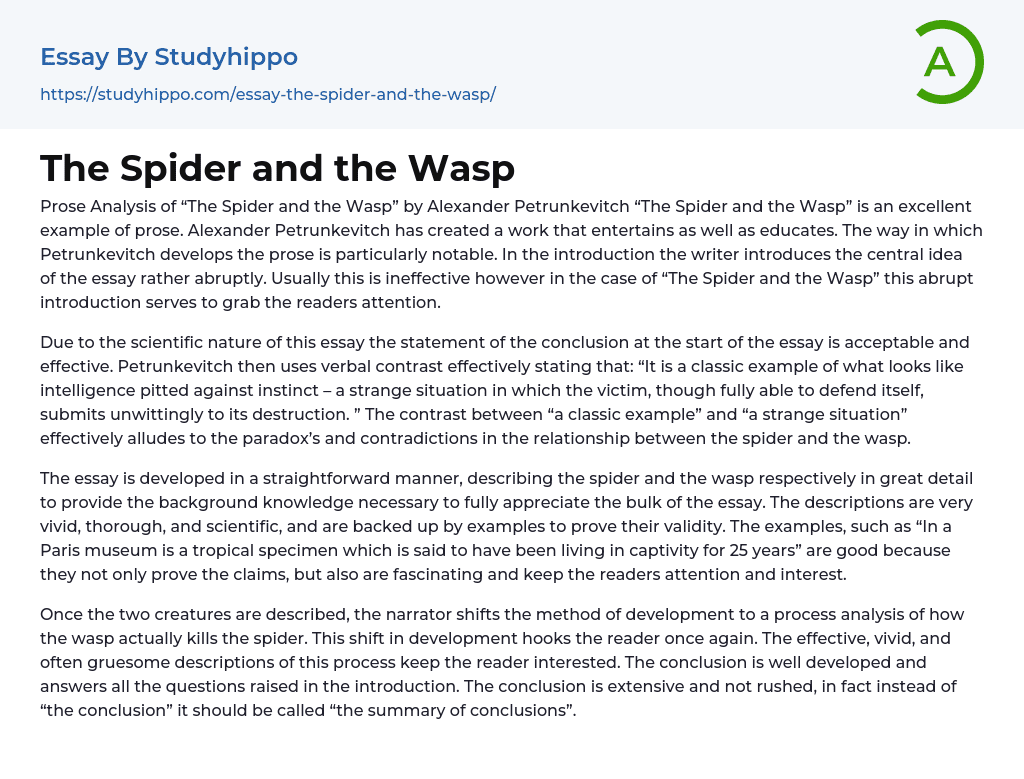Prose Analysis of “The Spider and the Wasp” by Alexander Petrunkevitch “The Spider and the Wasp” is an excellent example of prose. Alexander Petrunkevitch has created a work that entertains as well as educates. The way in which Petrunkevitch develops the prose is particularly notable. In the introduction the writer introduces the central idea of the essay rather abruptly. Usually this is ineffective however in the case of “The Spider and the Wasp” this abrupt introduction serves to grab the readers attention.
Due to the scientific nature of this essay the statement of the conclusion at the start of the essay is acceptable and effective. Petrunkevitch then uses verbal contrast effectively stating that: “It is a classic example of what looks like intelligence pitted against instinct – a strange situation in which the victim, thou
...gh fully able to defend itself, submits unwittingly to its destruction. ” The contrast between “a classic example” and “a strange situation” effectively alludes to the paradox’s and contradictions in the relationship between the spider and the wasp.
The essay is developed in a straightforward manner, describing the spider and the wasp respectively in great detail to provide the background knowledge necessary to fully appreciate the bulk of the essay. The descriptions are very vivid, thorough, and scientific, and are backed up by examples to prove their validity. The examples, such as “In a Paris museum is a tropical specimen which is said to have been living in captivity for 25 years” are good because they not only prove the claims, but also are fascinating and keep the readers attention and interest.
Once the two creature
are described, the narrator shifts the method of development to a process analysis of how the wasp actually kills the spider. This shift in development hooks the reader once again. The effective, vivid, and often gruesome descriptions of this process keep the reader interested. The conclusion is well developed and answers all the questions raised in the introduction. The conclusion is extensive and not rushed, in fact instead of “the conclusion” it should be called “the summary of conclusions”.
- Auction essays
- Balanced Scorecard essays
- Business Plans essays
- Expense essays
- Income essays
- Net Income essays
- Security Guard essays
- Singapore Airlines essays
- Battle essays
- Intranet essays
- Maintenance essays
- Simulation essays
- Inn essays
- Chief Executive Officer essays
- Convenience Store essays
- Firm essays
- Training And Development essays
- Unilever essays
- Variable Cost essays
- Virgin Group essays
- Bargaining essays
- Entity essays
- Pest analysis essays
- Leadership and Management essays
- Change Management essays
- Project Management essays
- Knowledge Management essays
- Operations Management essays
- Quality Management essays
- Risk Management essays
- Scientific Management essays
- supply chain management essays
- Performance Management essays
- Time Management essays
- Brand Management essays
- Total Quality Management essays
- Risk essays
- Manager essays
- Leadership essays
- Business Ethics essays
- Board Of Directors essays
- Product Management essays
- Comparative Analysis essays
- Decision Making essays
- Dispute Resolution essays
- Stress Management essays
- Business Management essays
- Brand Equity essays
- Branding essays
- Nike, Inc. essays




